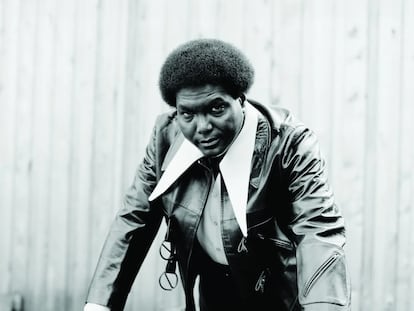The 15 best blues rock songs in history, according to Javier Vargas
The Spanish guitar player presents a selection of his favorite songs from a genre that has produced legends like Eric Clapton, Jimi Hendrix and Jeff Beck
Few Spanish guitarists have had the international exposure of Javier Vargas, who has played at the biggest blues festivals in the world and shared the stage with musicians like Buddy Guy, Carlos Santana, Glen Hughes and Johnny Winter. His career includes more than twenty records made with the Vargas Blues Band, whose most recent work consists of two albums: Stoner Night and Stoner Night Vol. II, the former with a blues rock feeling, the latter more inclined towards psychedelia, but both with the electric guitar as the protagonist.
We asked Vargas to choose his 15 favorite songs within his specialty, blues rock. “When the Fender Telecaster [guitar] came out, the blues became electrified, and with Jim Marshall and his amplifiers blues rock was born in the 1960s at the hands of Eric Clapton and Jimi Hendrix.” The following is his selection, accompanied by his own commentaries. The songs are listed in chronological order.
The Rolling Stones, Little Red Rooster (1964). “When Keith Richards straps on his Gibson Les Paul Junior guitar at a Rolling Stones concert, it quite possibly is to play Little Red Rooster. They got Chicago blues perfectly figured out: the harmonica, the guitar…”
John Mayall & the Blues Breakers with Eric Clapton, Hideaway (1966). “This whole album, which was called The Beano Album, is a thing of wonder. Eric Clapton’s guitar distortion was stunning. That was the first record where a blues guitarist turned the volume up that high. In those years the ear was not used to someone saturating an amplifier at those levels. The technician would freak out and tell Clapton that the sound was in the red. Clapton would reply: ‘It’s better, it’s better this way.’”
Jimi Hendrix, Red House (1967). “I heard it for the first time on the radio when I was in Argentina; it was a live version. I was very surprised because it sounded so intense and mystical. I learned to play the guitar by listening to these songs on the radio. I was trying to imitate those notes.”
Cream, Crossroads (1968). “I discovered British blues thanks to this song. When I was about 12 years old and living in Argentina [Vargas lived in several Latin American countries due to his father’s job], one day a neighbor played this song for me at his house. It was an electric version of a Robert Johnson song. There I discovered a series of sounds and it opened my senses so much that it influenced me to be a guitarist. Eric Clapton, Jack Bruce and Ginger Baker achieved a sound that was something new. When Jimi Hendrix went to England and heard it, he immediately wanted to meet Clapton.”
The Jeff Beck Group, Blues Deluxe (1968). “As a guitar player, Jeff Beck has never been particularly drawn to the blues, even though he played very well. Maybe the simplicity of the blues put him off. But both the version he did with The Jeff Beck Group and the one he played with Carmine Appice and Tim Bogert from Blues Deluxe were extraordinary. Jeff Beck made the guitar talk, he grabbed the blues and took it a step further.”
Fleetwood Mac, Black Magic Woman (1968). “In their early days, Fleetwood Mac, with Peter Green, were blues purists. They recorded at the Chess Studios in Chicago and collaborated with black blues legends like Willie Dixon and Buddy Guy. Then Green disappeared due to the influence of LSD, Stevie Nicks and Lindsey Buckingham arrived, and they became something else. The first time I heard Black Magic Woman it was the original Peter Green version. Then Santana included it in Abraxas and it became more popular than the original.”
Johnny Winter, Mean Town Blues (1969). “Johnny Winter is one of the great blues guitarists. They say that an albino is the closest there is to a black guy. And black people are the best at playing the blues, it’s a fact, they have something special when it comes to hitting the notes, it’s in their genes. And when it comes to singing and playing, Johnny Winter is very close to an African-American. There are mind blowing 10-minute versions of Mean Town Blues. I was lucky enough to play with Johnny three times. He was a prodigy.”
Led Zeppelin, Since I’ve Been Loving You (1970). “It’s not your typical 12-bar blues. It has a structure and arpeggios that take it to an epic level. Jimmy Page was inspired by Jeff Beck with this blues. Led Zeppelin was neither a blues nor a hard rock band. They had a very open concept: they could play jazz-rock, folk, Celtic music… I loved that variety.”
The Allman Brothers Band, Statesboro Blues (1971). “I first heard the Allman Brothers when I arrived in Caracas, Venezuela, in 1971. This song belongs to the album At Fillmore East, which a friend who played the drums in a band we put together there played for me. To me, this is the best southern rock album in history. With this album, Duane Allman got me into the slide guitar sound.”
ZZ Top, Waitin’ for the Bus (1973). “In the mid-1970s I lived in the United States and saw a lot of cover bands that played Waitin’ for the Bus. I didn’t know whose song it was. Then in 1975 I went to Memphis with a friend to see the Rolling Stones. The opening act was ZZ Top, which I didn’t know. And to my surprise they started the concert with Waitin’ for the Bus. They brought down the stadium. It was an amazing sound. That’s when I found out it was their song. The next day I went to a store and bought the Tres Hombres vinyl record, which is where this song is included. Since then it became one of my favorite bands of all time. Billy Gibbons’ greasy Texas riffs are amazing, and those deep vocals…”
Rory Gallagher, Who’s That Coming? (1973). “I discovered this song in Spain, on the radio. I didn’t know Rory Gallagher and I immediately noticed that he played slide guitar very well, which I had discovered with Duane Allman. I became a Rory fan. Then I toured with the bass player and the drummer from Taste, Rory’s first band.”
Stevie Ray Vaughan, Texas Flood (1982). “Stevie Ray Vaughan’s name should be inscribed in gold letters in the history of blues rock. In the mid-1970s there was a very important punk movement, with the Ramones, the Sex Pistols, The Clash… I liked it, but it seemed very weird to me because, until then, if you wanted to be in music you had to play very well and practice. I was in London and I lived that new wave and punk very intensely. I went to rooms where up to 10 bands played. I noticed that they were groups that didn’t know how to play. They were out of tune. I just thought, ‘Yikes, where is music headed?’ Then I accepted that movement and I really liked The Clash, The Police, The Jam... Then came the 1980s, with the new romantics and synthesizers... It all seemed very strange to me, coming from the blues, the Allman Brothers, the Rolling Stones... Until suddenly a friend gave me a Stevie Ray Vaughan tape. I’d never heard him, but I had seen pictures of him in magazines like Guitar Player. But now the photos had sound. Texas Flood was on that tape, and it blew my mind. I thought that that album was going to change the concept of music in the 1980s, and indeed, it did. Even David Bowie invited him to play in Let’s Dance. Stevie came to remind us where all the music came from. Such a shame that he died so young.”
Gary Moore, Still Got the Blues (For You) (1990). “Gary Moore came from playing hard rock with Thin Lizzy and some solo albums. The first time I saw him was in 1978 with Colosseum, in Madrid, in the auditorium. We were 50 people. Gary’s fingers were incredible. In the 1990s he returned to the sound of British blues. It’s an album with influences from John Mayal and the Blues Breakers and Peter Green, but with a sound from the time he released it, the 1990s. Blues purists gave Gary Moore and Stevie Ray Vaughan hell because they said it was more rock than blues, but they later had to admit that they brought blues out of oblivion and made it fashionable again.”
Buddy Guy, Damn Right, I’ve Got the Blues (1991). “Buddy Guy is one of the most amazing Chicago guitar players. The first time I saw him was at the end of the 1980s in Barcelona, together with the harmonica player Junior Wells. Later they hired me to play for 15 days at their Chicago venue, the Buddy Guy Legend. And I talked a lot with him. He is a wise guy. He still lives: he is 86 years old. Buddy Guy and Albert Collins are probably my favorite black guitarists.”
Joe Bonamassa, Sloe Gin (2007). “Joe Bonamassa is the greatest current blues musician in the United States. He started playing for 200 people and now fills concert halls. This song represents his style.”
Sign up for our weekly newsletter to get more English-language news coverage from EL PAÍS USA Edition
Tu suscripción se está usando en otro dispositivo
¿Quieres añadir otro usuario a tu suscripción?
Si continúas leyendo en este dispositivo, no se podrá leer en el otro.
FlechaTu suscripción se está usando en otro dispositivo y solo puedes acceder a EL PAÍS desde un dispositivo a la vez.
Si quieres compartir tu cuenta, cambia tu suscripción a la modalidad Premium, así podrás añadir otro usuario. Cada uno accederá con su propia cuenta de email, lo que os permitirá personalizar vuestra experiencia en EL PAÍS.
¿Tienes una suscripción de empresa? Accede aquí para contratar más cuentas.
En el caso de no saber quién está usando tu cuenta, te recomendamos cambiar tu contraseña aquí.
Si decides continuar compartiendo tu cuenta, este mensaje se mostrará en tu dispositivo y en el de la otra persona que está usando tu cuenta de forma indefinida, afectando a tu experiencia de lectura. Puedes consultar aquí los términos y condiciones de la suscripción digital.
More information
Archived In
Últimas noticias
There is as much life left to discover on planet Earth as that which is already known
Dozens presumed dead, around 100 injured in fire at Swiss Alps bar during New Year’s celebration
Is porn for women different from conventional porn? We spoke to those who make it
Cartagena de Indias is sinking: What can the city do to mitigate it?
Most viewed
- David King, chemist: ‘There are scientists studying how to cool the planet; nobody should stop these experiments from happening’
- Reinhard Genzel, Nobel laureate in physics: ‘One-minute videos will never give you the truth’
- Oona Chaplin: ‘I told James Cameron that I was living in a treehouse and starting a permaculture project with a friend’
- Sinaloa Cartel war is taking its toll on Los Chapitos
- The Interoceanic Train, the Mexican alternative to the Panama Canal











































